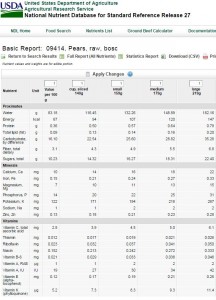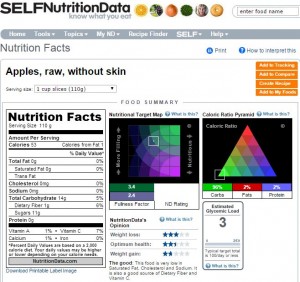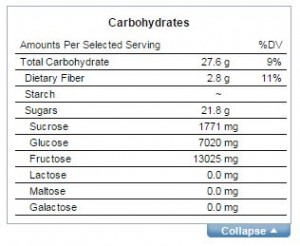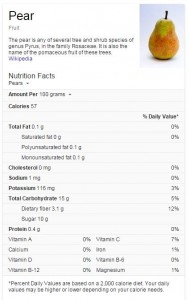These days, I need to know what the nutritional values of foods are. I’ve found a ton of places online that show you the values – some with uber fancy graphical images, some with just the calories and fat amounts, and some with information that no one can decipher.
What I want in a database:
- I want standardized measurement selections (50 grams, 100 grams, 1 ounce, 2 ounces), etc.
- I want to compare food items (example: skim vs regular milk)
- I want a breakdown of where the calories are coming from (fat, carbs, protein?)
- I want a breakdown of the types of carbohydrates (sugars)
- I want the glycemic index and glycemic load calculation
I found a few ways that worked for me.
1. Google
I’ve found one of the easiest ways to get nutritional info directly from Google is using one or the other terms: “Nutrition” or “Carbs” For example, searching for pear nutrition or pear carbs will bring up the relevant nutritional values associated with a pear. Any pear, not specific pears. It does have weird (and seemingly arbitrary) serving size amounts. For the most part, it does allow for at least 100 grams on most items. If you run the values of a lot of items, always use the same amounts, if possible, to give yourself an understanding of the real value. I mean, you might want to know the values on oatmeal, but you don’t need to know what 1 cup of dry, uncooked oatmeal is..you want to know what a serving 1/4 cups or 125 grams is. Try to select the amount closest to what you know you are going to eat, and what you have seen.
Google’s data does not have some of my requirements – no breakdowns, no glycemic index or load – very sad, since this is the fastest way to search. But just knowing carbs/fiber on an ingredient is helpful.
2. USDA
United States Department of Agriculture, Agricultural Research Service has an online database, “National Nutrient Database for Standard Reference“, which is an excellent resource for most foods. The database allows you to input your own weights and measures for items, which is really great. It also seems to have a lot of items, including many fresh and raw items, plus some prepared items. I like the breakdowns, though the sugars are not broken down as well as I would like. In addition, you can download an excel file with all the information included. There is also an ability to use the API and create your own app, if you are so inclined. Anyone??!
Service has an online database, “National Nutrient Database for Standard Reference“, which is an excellent resource for most foods. The database allows you to input your own weights and measures for items, which is really great. It also seems to have a lot of items, including many fresh and raw items, plus some prepared items. I like the breakdowns, though the sugars are not broken down as well as I would like. In addition, you can download an excel file with all the information included. There is also an ability to use the API and create your own app, if you are so inclined. Anyone??!
Again, my own requirements aren’t met here, though the database does allow for input of my own measurements — 1/2 cup or 3 ounces, or 100 grams. No glycemic load or index.
3. Self Nutrition Data
The last link is probably my favorite. Not only does it show you the nutritional values,  have ease of selecting weight/measurement, have tools to compare various items (!!) etc., but it shows you the glycemic load for the selected food and serving size. This site also has useless (to me) graphs & graphics. But because I want the carb/sugars broken down, and I want to see the glycemic load, this site is incredibly useful and the one I use the most.
have ease of selecting weight/measurement, have tools to compare various items (!!) etc., but it shows you the glycemic load for the selected food and serving size. This site also has useless (to me) graphs & graphics. But because I want the carb/sugars broken down, and I want to see the glycemic load, this site is incredibly useful and the one I use the most.

